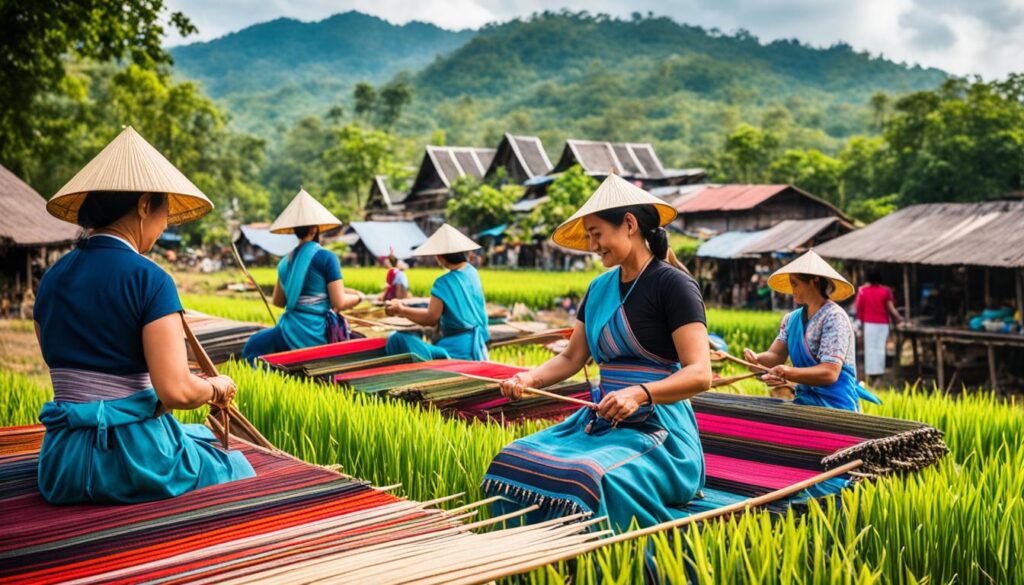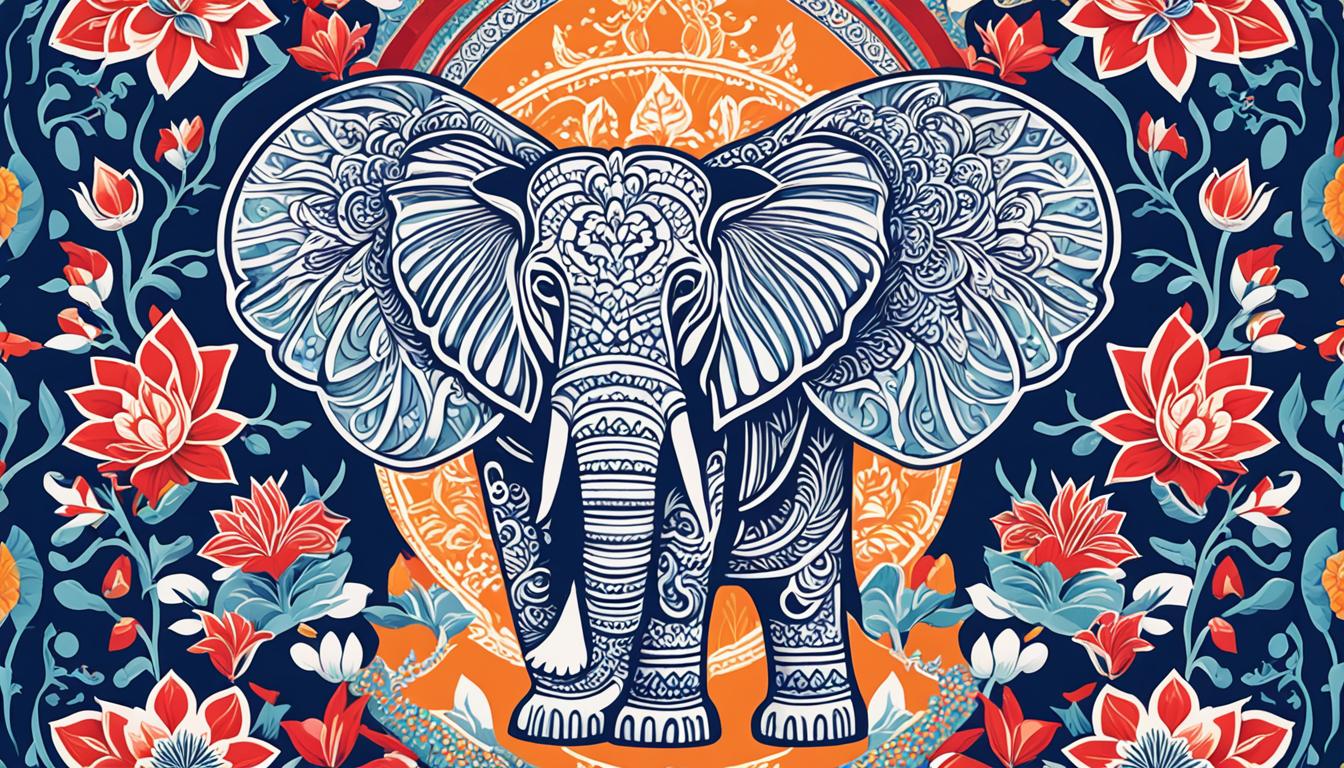Did you know that the Korat Language, also known as the Korat dialect, is spoken by a significant ethnic group in Thailand’s Nakhon Ratchasima Province? This fascinating language has its own distinct words, dialect, costumes, songs, and beliefs, setting it apart from other Thai-speaking peoples.
While the origins of the Korat Thai people are a blend of Thai, Lao, Khmer, and Kui cultures, they primarily speak Central Thai. The population of the Korat Thai people is estimated to be around 600,000, according to Thailand’s 2011 report to the UN Committee on the Elimination of Racial Discrimination.
Discover the history, cultural significance, distribution, and population of the Korat Thai people as we delve into the fascinating world of the Korat Language in Thailand.
History and Origin of Korat Language
The Korat Thai language has a rich history that can be traced back to the late 17th century during the Ayutthaya Kingdom. King Narai, recognizing the strategic importance of the northeastern frontier, ordered the construction of a new city in Nakhon Ratchasima. This city, known as Korat, became the cultural and linguistic center for the Korat Thai people.
Historically, the Korat Thai people have deep ties to the Thai people, with legends suggesting that they are descended from Thai soldiers who married Khmer women. Over the years, the Korat Thai language has developed its own distinct dialect and cultural identity. It is part of the diverse tapestry of Thai dialects and regional languages spoken in Thailand.
The Isan region, where Nakhon Ratchasima is located, is known for its unique linguistic landscape. Alongside the Korat Thai language, various other Thai dialects and regional languages are spoken, reflecting the rich cultural heritage of the region. These regional languages contribute to the linguistic diversity of Thailand and serve as a testament to the country’s multiculturalism.
“The Korat Thai language is a testament to the cultural fusion and historical developments in the Isan region, reflecting the unique heritage of the Korat Thai people.”
The Korat Thai language is not only limited to Nakhon Ratchasima Province but also extends to adjacent provinces such as Saraburi, Lopburi, Phetchabun, Chaiyaphum, and Buriram. This dispersion highlights the influence and reach of the Korat Thai language in the broader Isan region.
Throughout the centuries, the Korat Thai language has played a crucial role in shaping the cultural identity of not only the Korat Thai people but also the greater Isan region. It serves as a testament to the rich history and cultural heritage of Thailand, showcasing the diverse linguistic landscape and the blending of various ethnic influences.
| Dialect/Region | Location |
|---|---|
| Korat Thai | Nakhon Ratchasima, Saraburi, Lopburi, Phetchabun, Chaiyaphum, Buriram |
| Isan Thai | Isan region |
| Central Thai | Central Thailand |
| Southern Thai | Southern Thailand |
| Northern Thai | Northern Thailand |
The table above showcases the distribution of various Thai dialects and regional languages in Thailand. The Korat Thai language, spoken in Nakhon Ratchasima and adjacent provinces, is an integral part of this linguistic mosaic.
Next, we will explore the cultural significance of the Korat Thai language and its role in preserving the unique heritage of the Korat Thai people.
Cultural Significance of the Korat Language
The Korat Thai language holds immense cultural significance for the Korat Thai people, forming an integral part of their rich heritage. Their unique culture, known as the Khorat culture, shares similarities with the Thai culture in the central plains, yet possesses distinct elements, particularly in terms of language. In addition to the official Thai language, the Korat Thai people have their own traditional words, dialect, costumes, songs, and beliefs. These cultural expressions distinguish them from other Tai-speaking communities, contributing to the diverse linguistic and cultural tapestry of Thailand.
Despite residing in the Isan region, which is predominantly inhabited by northeast Thai speakers, the Korat Thai people have managed to preserve their fluency in the official Thai language. This exemplifies their commitment to bilingualism and their ability to navigate between their native dialect and the broader Thai language spoken throughout the country.
“The Korat Thai language and its cultural manifestations, such as traditional songs and costumes, provide a unique identity to the Korat Thai people within Thailand’s multicultural society. They embody the rich tapestry of the country’s linguistic and cultural diversity.”
The Khorat culture, with its distinctive language, plays a vital role in shaping the social fabric and collective identity of the Korat Thai community. It serves as a means of preserving their cultural heritage and fostering a sense of belonging among its members. Through their language, the Korat Thai people pass on their traditions, values, and stories from one generation to the next, ensuring the continuity of their cultural legacy.
The cultural significance of the Korat language extends beyond the boundaries of the Korat Thai community—it represents a larger symbol of the vibrant and diverse traditions that exist within Thailand. It is through the preservation and celebration of languages like Tai Beung, Thai Doeng, and Tai Derng that the country’s cultural tapestry is enriched and its cultural identity remains strong.
Illustration

Distribution and Population of Korat Thai People
The Korat Thai people are primarily concentrated in Nakhon Ratchasima Province, situated in the northeastern region of Thailand. They inhabit all districts of the province, except for the northern part. In addition to Nakhon Ratchasima, the Korat Thai people have significant populations in adjacent provinces such as Saraburi, Lopburi, Phetchabun, Chaiyaphum, and Buriram.
According to Thailand’s 2011 report to the UN Committee on the Elimination of Racial Discrimination, the population of the Korat Thai people is estimated to be around 600,000. While Nakhon Ratchasima Province is their main stronghold, smaller villages in and around Nakhon Ratchasima City are also home to a few thousand Korat Thai individuals.
The distribution and preservation of the Korat Thai people’s culture and language are closely tied to their geographical concentration in Nakhon Ratchasima Province and the surrounding areas. This localized presence has allowed the community to maintain their traditions and pass them down through generations.
To better illustrate the distribution of the Korat Thai people, the table below provides an overview of their population in the key provinces. It showcases their significant presence in Nakhon Ratchasima Province as well as their spread across neighboring regions.
| Province | Estimated Population |
|---|---|
| Nakhon Ratchasima | 600,000 |
| Saraburi | 50,000 |
| Lopburi | 40,000 |
| Phetchabun | 30,000 |
| Chaiyaphum | 20,000 |
| Buriram | 10,000 |
Conclusion
The Korat Language, spoken by the Korat Thai people, is an integral part of the rich cultural heritage of the Isan region in Northeast Thailand. The Korat Thai people have their own unique dialect, costumes, songs, and traditions that set them apart from the Thai-speaking populations in other parts of the country.
With their distinct language and culture, the Korat Thai people contribute to the vibrant tapestry of Thai culture. Their traditions reflect the influences of Thai, Lao, Khmer, and Kui cultures, creating a unique fusion that is characteristic of the Isan region. The Korat Language serves as a bridge that connects the Korat Thai people with their cultural roots and helps preserve their ancestral heritage.
As an important regional language, the Korat Language signifies the cultural diversity and richness of Northeast Thailand. It is a testament to the resilience and vibrancy of the Korat Thai people, who have upheld their language and traditions throughout history. By embracing and celebrating the Korat Language, we recognize and honor the unique contributions of the Korat Thai people to the broader fabric of Thai culture.
